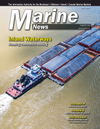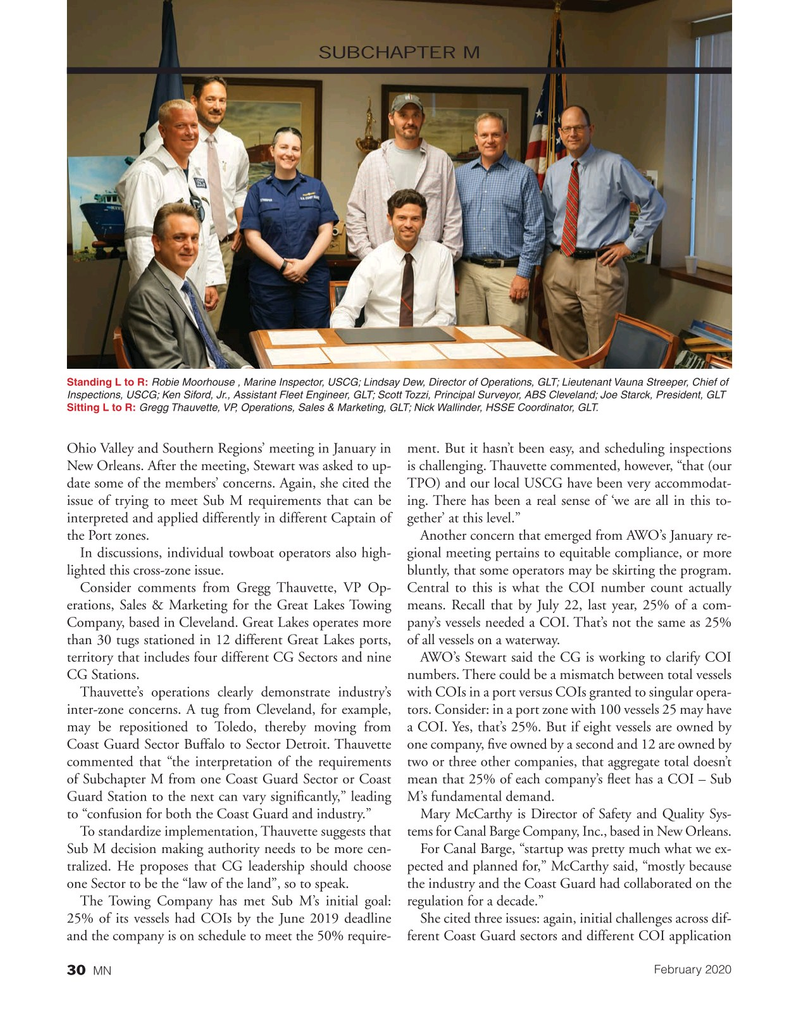
Page 30: of Marine News Magazine (February 2020)
Pushboats,Tugs & Assist Vessels
Read this page in Pdf, Flash or Html5 edition of February 2020 Marine News Magazine
SUBCHAPTER M
Standing L to R: Robie Moorhouse , Marine Inspector, USCG; Lindsay Dew, Director of Operations, GLT; Lieutenant Vauna Streeper, Chief of
Inspections, USCG; Ken Siford, Jr., Assistant Fleet Engineer, GLT; Scott Tozzi, Principal Surveyor, ABS Cleveland; Joe Starck, President, GLT
Sitting L to R: Gregg Thauvette, VP, Operations, Sales & Marketing, GLT; Nick Wallinder, HSSE Coordinator, GLT.
Ohio Valley and Southern Regions’ meeting in January in ment. But it hasn’t been easy, and scheduling inspections
New Orleans. After the meeting, Stewart was asked to up- is challenging. Thauvette commented, however, “that (our date some of the members’ concerns. Again, she cited the TPO) and our local USCG have been very accommodat- issue of trying to meet Sub M requirements that can be ing. There has been a real sense of ‘we are all in this to- interpreted and applied differently in different Captain of gether’ at this level.” the Port zones. Another concern that emerged from AWO’s January re-
In discussions, individual towboat operators also high- gional meeting pertains to equitable compliance, or more lighted this cross-zone issue. bluntly, that some operators may be skirting the program.
Consider comments from Gregg Thauvette, VP Op- Central to this is what the COI number count actually erations, Sales & Marketing for the Great Lakes Towing means. Recall that by July 22, last year, 25% of a com-
Company, based in Cleveland. Great Lakes operates more pany’s vessels needed a COI. That’s not the same as 25% than 30 tugs stationed in 12 different Great Lakes ports, of all vessels on a waterway.
territory that includes four different CG Sectors and nine AWO’s Stewart said the CG is working to clarify COI
CG Stations. numbers. There could be a mismatch between total vessels
Thauvette’s operations clearly demonstrate industry’s with COIs in a port versus COIs granted to singular opera- inter-zone concerns. A tug from Cleveland, for example, tors. Consider: in a port zone with 100 vessels 25 may have may be repositioned to Toledo, thereby moving from a COI. Yes, that’s 25%. But if eight vessels are owned by
Coast Guard Sector Buffalo to Sector Detroit. Thauvette one company, ? ve owned by a second and 12 are owned by commented that “the interpretation of the requirements two or three other companies, that aggregate total doesn’t of Subchapter M from one Coast Guard Sector or Coast mean that 25% of each company’s ? eet has a COI – Sub
Guard Station to the next can vary signi? cantly,” leading M’s fundamental demand.
to “confusion for both the Coast Guard and industry.” Mary McCarthy is Director of Safety and Quality Sys-
To standardize implementation, Thauvette suggests that tems for Canal Barge Company, Inc., based in New Orleans.
Sub M decision making authority needs to be more cen- For Canal Barge, “startup was pretty much what we ex- tralized. He proposes that CG leadership should choose pected and planned for,” McCarthy said, “mostly because one Sector to be the “law of the land”, so to speak. the industry and the Coast Guard had collaborated on the
The Towing Company has met Sub M’s initial goal: regulation for a decade.” 25% of its vessels had COIs by the June 2019 deadline She cited three issues: again, initial challenges across dif- and the company is on schedule to meet the 50% require- ferent Coast Guard sectors and different COI application
February 2020 30 MN

 29
29

 31
31
